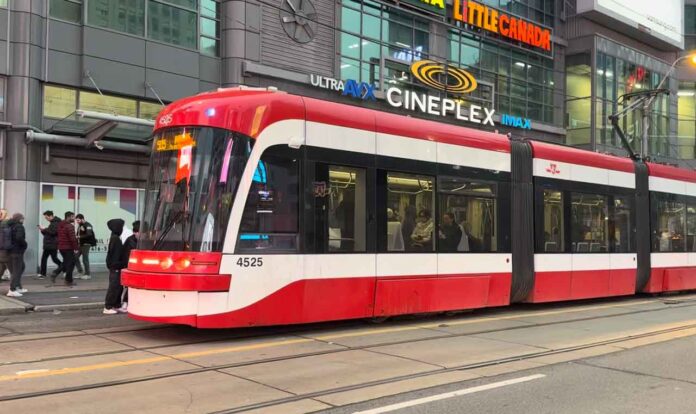Infra
Doug Ford Announces Major Plans to Combat Toronto Gridlock with ‘Game-Changing’ Legislation – Colitco

Ontario Premier Doug Ford has unveiled plans to address Toronto’s chronic traffic congestion, promising “game-changing” changes in an upcoming round of legislation. The new measures aim to alleviate gridlock on two key routes, the Gardiner Expressway and Highway 401, which have been notorious for bottlenecks.
Speaking at the Toronto Region Board of Trade, Ford highlighted his commitment to tackling the city’s growing traffic woes. The premier, addressing the need for significant infrastructure improvements, stated his focus would be on the Gardiner Expressway and Highway 401.
Ford’s plan promises to bring about what he called “game-changing” improvements to Toronto’s traffic system. The Gardiner Expressway, now under provincial control after a transfer from the City of Toronto, remains a key focus. The years-long rehabilitation project on the Gardiner has only worsened congestion, which the government hopes to ease.
Additionally, Ford pinpointed Highway 401 as a priority. He stressed that reducing congestion on the 401 would play a critical role in improving the overall traffic flow across Toronto.
While the details of the plan remain unclear, Ford’s commitment to alleviating gridlock on these two routes signals a shift towards making Toronto’s roads more efficient.
During the announcement, Ford hinted at innovative ideas that could transform Toronto’s roads. In the past, he has proposed solutions like tunnelling beneath highways or building multiple layers of roads above existing infrastructure. He likened these ideas to projects in cities such as New York and certain Asian countries, where multi-layered roads and decking projects have become common solutions.
While Ford acknowledged that these ideas might come with high costs, his administration remains keen on exploring their feasibility. “Let’s find out the cost,” he said, noting that engineering such projects is possible, though the financial burden could be significant.
Experts warn that expanding highways may not provide long-term relief. Matti Siemiatycki, Director of the Infrastructure Institute at the University of Toronto, explained that adding lanes or new infrastructure can lead to a phenomenon called “induced demand.” This occurs when increased capacity attracts more vehicles, eventually leading to the same congestion issues.
“In a lot of Asia, they’re doing decking projects,” Siemiatycki said. “However, the cost of these initiatives is astronomical. You often end up with additional lanes also becoming congested.”
Also Read: The Rise of the COVID-19 XEC Variant: What You Need to Know
Opposition parties, including the Ontario NDP, have been vocal in their criticism of Ford’s highway-centric approach. Instead of building new roads, they advocate for using existing infrastructure, particularly the toll-based Highway 407. By subsidising the cost of trucks using Highway 407, they argue that congestion on Highway 401 could be alleviated without the need for new highways or additional lanes.
Ontario Green Party leader Mike Schreiner believes that subsidising truck tolls on Highway 407 would be a more efficient solution than building new highways. “It’s more fiscally and environmentally responsible to pay the tolls of truckers than to construct new highways,” Schreiner stated. He argues that diverting trucks from Highway 401 to Highway 407 would deliver immediate results.
Ford’s most ambitious proposal yet is the idea of a traffic tunnel beneath Highway 401. Announced during a news conference in Etobicoke, this concept involves a tunnel running from Brampton or Mississauga in the west to Scarborough or Markham in the east—a stretch covering roughly 55 kilometres.
Ford confirmed that an internal feasibility study by the Ministry of Transportation is underway to evaluate the project’s costs and timelines. If realised, this tunnel could become one of the world’s largest infrastructure projects. The premier emphasised that the tunnel would “cut gridlock, support economic growth, and help get people moving faster.”
Ford also assured that his government would be transparent about the potential costs, although similar promises have been met with scepticism due to the secrecy surrounding the costs of other projects, such as Highway 413.
Ford’s urgency stems from a growing traffic crisis in the Greater Toronto Area. The Toronto Region Board of Trade estimates that gridlock costs Ontario an estimated $11 billion in lost productivity each year. Traffic congestion on every 400-series highway, including Highway 407, is expected to reach capacity within the next decade, according to the Ministry of Transportation.
By 2051, average travel times on Highway 401 are expected to double, adding an additional 90 minutes to many commutes. “We can’t just sit by and let this happen. We need to keep building,” Ford said, stressing the necessity of immediate action.
The premier’s plans for addressing Toronto’s traffic congestion reflect both bold ideas and high-stakes decisions. Whether through tunnels beneath Highway 401 or expanding existing routes, Ford remains committed to tackling gridlock head-on.
As the feasibility study for the tunnel project unfolds, Ontarians can expect more updates on how Ford’s government plans to reshape the future of transportation in the Greater Toronto Area.
Visited 3 times, 3 visit(s) today









